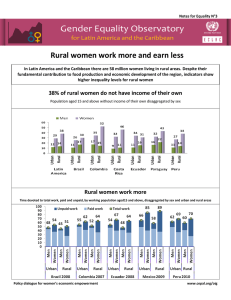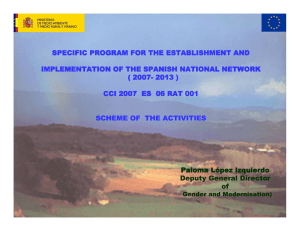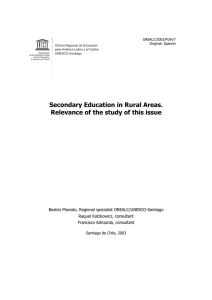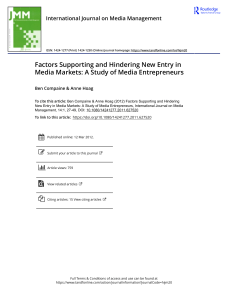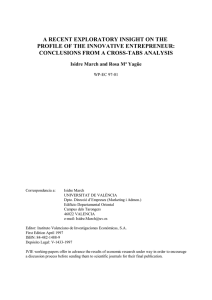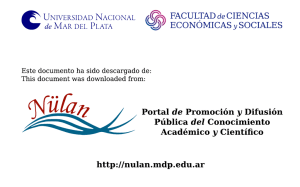WOMEN AS ENTREPRENEURSHIP UNDER THE
Anuncio
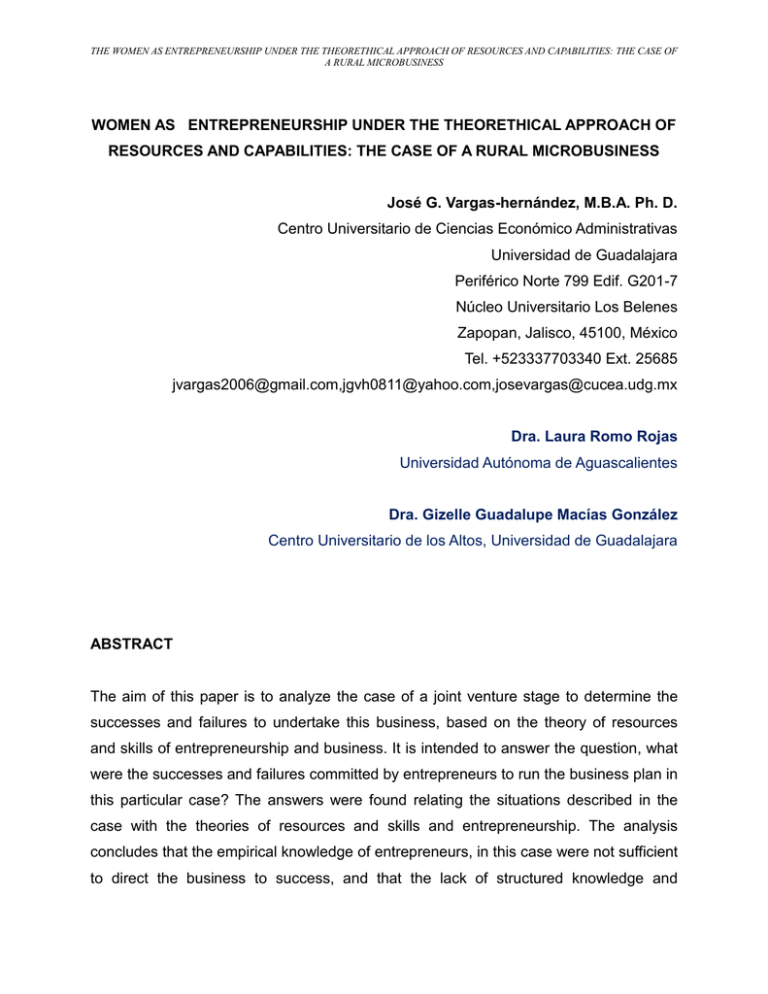
THE WOMEN AS ENTREPRENEURSHIP UNDER THE THEORETHICAL APPROACH OF RESOURCES AND CAPABILITIES: THE CASE OF A RURAL MICROBUSINESS WOMEN AS ENTREPRENEURSHIP UNDER THE THEORETHICAL APPROACH OF RESOURCES AND CAPABILITIES: THE CASE OF A RURAL MICROBUSINESS José G. Vargas-hernández, M.B.A. Ph. D. Centro Universitario de Ciencias Económico Administrativas Universidad de Guadalajara Periférico Norte 799 Edif. G201-7 Núcleo Universitario Los Belenes Zapopan, Jalisco, 45100, México Tel. +523337703340 Ext. 25685 jvargas2006@gmail.com,jgvh0811@yahoo.com,josevargas@cucea.udg.mx Dra. Laura Romo Rojas Universidad Autónoma de Aguascalientes Dra. Gizelle Guadalupe Macías González Centro Universitario de los Altos, Universidad de Guadalajara ABSTRACT The aim of this paper is to analyze the case of a joint venture stage to determine the successes and failures to undertake this business, based on the theory of resources and skills of entrepreneurship and business. It is intended to answer the question, what were the successes and failures committed by entrepreneurs to run the business plan in this particular case? The answers were found relating the situations described in the case with the theories of resources and skills and entrepreneurship. The analysis concludes that the empirical knowledge of entrepreneurs, in this case were not sufficient to direct the business to success, and that the lack of structured knowledge and THE WOMEN AS ENTREPRENEURSHIP UNDER THE THEORETHICAL APPROACH OF RESOURCES AND CAPABILITIES: THE CASE OF A RURAL MICROBUSINESS adequate scientific support for this project strongly directed towards the nonpermanence on the market. Keywords: Entrepreneurship, women entrepreneurs, PROMUSAG, resources and capabilities, competitive advantage. RESUMEN El objetivo de este documento es analizar el caso de una empresa en etapa de emprendimiento, para determinar los aciertos y fallas al emprender este negocio, con base en la teoría de recursos y capacidades y la del emprendimiento empresarial. Se pretende dar una respuesta a la pregunta, ¿cuáles fueron los aciertos y fallas cometidos por los emprendedores al ejecutar el proyecto de negocio en el caso analizado? Las respuestas se encontraron relacionando las situaciones expuestas en el caso con las teorías de recursos y capacidades y la del emprendedurismo. El análisis llega a la conclusión de que los conocimientos empíricos de los emprendedores, en este caso, no fueron suficientes para encaminar hacia el éxito este negocio, y que la falta de conocimientos estructurados y un adecuado apoyo científico dirigieron fuertemente este emprendimiento hacia la no permanencia en el mercado. Palabras clave: Emprendimiento empresarial, mujer emprendedora, PROMUSAG, recursos y capacidades, ventaja competitiva. 1. Introduction The Mexican government through the Ministry of Agrarian Reform supports rural entrepreneurship projects. One way is PROMUSAG (program for women in agriculture). This is a support program for rural women entrepreneurs, seeking their integration in the THE WOMEN AS ENTREPRENEURSHIP UNDER THE THEORETHICAL APPROACH OF RESOURCES AND CAPABILITIES: THE CASE OF A RURAL MICROBUSINESS productive sector to earn income to help in the fight against poverty in this rural environment. The support consists of a sum of money to start up the business to undertake, which is repayable but it is considered at lost funds. In 2009, hundreds of projects have benefited from PROMUSAG, one of which has been analyzed for this report. This case is featuring nine women in the municipality of San Martin de Hidalgo, Jalisco. In that year, nine women was PROMUSAG order required for each project. The team for this project consisted of women with little or no preparation in business, but the team had a leader with knowledge and skills acquired empirically that gave the project some routing to success. PROMUSAG central requirements requested to be eligible for funding to the various proposals were teams of nine members, all participants should be female, a project to undertake the business detailing emphasizing the distribution of grant money, it is sent to be developed by an engineer in the agricultural area and the last requirement was to have an area of land sufficient to carry out the purpose of the enterprise activity. The venture was marked by the fall in leader's illness, which conditioned the project to a resounding lack of profitability, this, coupled with the lack of scientific preparation and support scientists generated a mismanagement of resources and capabilities that had the project, bringing this to its final termination in six months. 2. Theoretical framework and literature review The enterprise is the basic and elemental production system of an economy, is an indivisible economic unit that is generated in the process of value creation that is the essence, purpose and function of the entire economic system (Alegre, Berne, & Galve, 1995). Strategic management is the scientific discipline that studies issues related to management of organizations and how are managed the functional areas of the firm. Just as the way the company has designed herself, to set their goals and values, and to relate to their environment. THE WOMEN AS ENTREPRENEURSHIP UNDER THE THEORETHICAL APPROACH OF RESOURCES AND CAPABILITIES: THE CASE OF A RURAL MICROBUSINESS According to Rumelt (1997), the purpose of the strategy is to provide partial support for the company to survive and be successful. Strategic management analyzes and determines the behavior of the target company specifically focuses on the determinants of competitive advantage and how it can be used to generate profits. In any organization or company, it is essential to have certain resources and capabilities that are the basis for the generation of competitive advantages, which are crucial to the achievement of the objectives of the firm, that is, to generate sales and more importantly, getting benefits. The theory of resources and capabilities focuses on the analysis of assets owned and / or controlled by companies, as well as their differences, and the importance of this fact to explain the evolution of the results (Barney, 1991). From this approach, the company is considered as a unique set of resources and capabilities with a unique story (Castro & Lopez, 2006). In this perspective the strategy is defined as a constant search and maintenance benefits, which shows the economic approach model (Reynoso, 2005). Achieving success in business depends on the performance of the tasks of management and internal coordination and the efficiency with which the company competes. The theory of resources and capabilities and the structural theory explain the existence of extraordinary benefits of this success, although the empirical analysis shows that the first explains even better. The value of the company is more related to intangibles than tangibles aspects on which the valuation was done traditionally (Jiménez, 1999). In turn, intangible resources and capabilities are usually based on information and knowledge, so they have no limits in their ability to use (Guerras & Navas, 2007) and therefore it is necessary to manage knowledge, which means managing the processes of creation, development, dissemination and exploitation of knowledge to gain organizational capacity (Revilla , 1995). This makes every day more evident that the value of the company that is more THE WOMEN AS ENTREPRENEURSHIP UNDER THE THEORETHICAL APPROACH OF RESOURCES AND CAPABILITIES: THE CASE OF A RURAL MICROBUSINESS related to intangible aspects than with tangible on which the valuation was done traditionally (Jiménez, 1999), and thus, with knowledge. According to Arranz (2000), when the company discusses how to achieve competitive advantage based on resources and capabilities, should take into account that these attributes, to become forms of knowledge, are the result of merging the ideas of the hierarchy with the rest of the organization. Ferrer (1989) argues that this merger or organizational ethos contains a latent energy of known and unknown resources, used or unused, which tells the company how to progress and change, because it can build on this potential enhanced capabilities and routines. Also these attributes should have the following characteristics: be valuable, rare or idiosyncratic, imperfectly imitable and transferable, and have hardly substitutes (Barney, 1991; Peteraf, 1993 and Fernández, 1993). Characteristics of valuable resources in the model of Barney (1991): Simplicity in use, shortages, difficult imitation, difficult to replace, analysis of managers. In addition there should be strategically equivalent resources, whose existence can be seen as an additional amount in offering a superior resource. Reynoso (2005) mentions three definitions of company capabilities: 1. - The company's capabilities are the skills that are equally to integrate, build and reconfigure internal and external competencies of the company in order to react quickly to the changing environment. 2. - Ability to use resources through organizational processes of the company, with the aim of obtaining a particular purpose. 3. - High level routines (or collection of routines) that, together with resource flows, provides company management a set of decision options for producing significant results. THE WOMEN AS ENTREPRENEURSHIP UNDER THE THEORETHICAL APPROACH OF RESOURCES AND CAPABILITIES: THE CASE OF A RURAL MICROBUSINESS Efficiency is manifested in three complementary aspects: strategic capabilities allow the company to perform functional activities in a better way than their competitors, will dynamically adjust to the demands of the environment and foster the enterprise to obtain strategic resources (Collis, 1994) Teece, Pisano, & Shuen (1997) mention that the capabilities of the company are supported by organizational processes, i.e., organizational routines that take place in the organizations and they have three functions: integration-coordination as static concept, learning as a dynamic concept and reconfiguration. Implications of learning: skills involves both the organization and the individual, organizational knowledge generated by activities that are performed on a daily basis in the company, reflected in new patterns of activity, in routines or a new organizational logic. Routines are patterns of interaction that represent successful solutions to particular problems. These behavioral patterns reside in behavioral groups where some simple routines can be represented by individual behaviors. One of the determinants of the strategic position of the company is the active control, which are plants and specialized equipment and, even more, the knowledge-based assets are difficult to trade and the complementary assets. These assets determine the market share and profitability at any given time. Asset capabilities relevant to the company can be classified in different ways. One is to use the following categories: technological, complementary, financial, associated to reputation with structural, institutional derivatives market structure and organizational boundaries (Teece, Pisano and Shuen, 1997). The orthodox explanatory scheme has eliminated the entrepreneur of this system has had its recognition throughout economic history, making it the fulcrum (pivot) on which everything turns business (Bustamante, 2004). The Royal Academy of the Spanish Language (La Real Academia de la Lengua Española, 2012) gives the following definition of an entrepreneur: "That undertakes with resolution difficult and eventful actions". THE WOMEN AS ENTREPRENEURSHIP UNDER THE THEORETHICAL APPROACH OF RESOURCES AND CAPABILITIES: THE CASE OF A RURAL MICROBUSINESS Entrepreneurs are considered an important part of the process of job creation and stimulating factor of growth as they create new businesses, and thus, creating more wealth and prosperity in a country (Martín, 2009). As defined by Wennekers, Sander, Thurik, & Roy (1999) the entrepreneur is linked to the manifest ability and desire of individuals, either by themselves or by teams within or outside existing organizations, to create new economic opportunities, that is, new products, new forms of organization, new methods of production, etc. and introduce their ideas in the markets, facing uncertainty and other obstacles, by making decisions on location and in the form and use of resources and institutions. Bilbao & Pachano (2002, p. 35), proposed the following definition of an entrepreneur: "The successful entrepreneur is a person with a dream, a goal, a desire to create, to innovate, to capture a business opportunity, which is able to" see "HIS idea into finished form, which is not stopped by obstacles, so the persistence and tenacity are typical characteristics of HIS behavior.” Malagón (2003) found that entrepreneurs meet the following characteristics: Constance. Sense or business opportunity. Knowledge. Personal responsibility. Leadership. To develop entrepreneurship, according to Rojas (2003) is: Make things, no look for excuses or reasons to prove that you can do. Getting stronger every time he falls, never dig in his heels to find the reason for his failure. THE WOMEN AS ENTREPRENEURSHIP UNDER THE THEORETHICAL APPROACH OF RESOURCES AND CAPABILITIES: THE CASE OF A RURAL MICROBUSINESS It is worthy, conscious, responsible for his actions. The creator of something, a home, a business. Understand that honest work, well there is not a need or sacrifice but a privilege and opportunity it gives us life. Dreaming of something, do it and discover how special and unique we are, are always positive. 3. The PROMUSAG program The Secretary of Agrarian Reform (Secretaría de la Reforma Agraria, SRA) is the institution of the Federal Government that serves women and men who live and work in the rural communities and ejidos or community´s owned land across the country. The SRA provides legal certainty for the owners of the land and promote comprehensive rural development social justice. One of the ways the SRA supports rural development is through the promotion of entrepreneurial and productive projects in ejidos and communities through its programs Support for Productive Projects in Agrarian Nucleolus Fund (Fondo de Apoyo para Proyectos Productivos en Núcleos Agrarios, FAPPA) Program for Women in the Agricultural Sector (Programa de la Mujer en el Sector Agrario, PROMUSAG) and Young Rural Entrepreneur and Land Fund (Joven Emprendedor Rural y Fondo de Tierras, JERFT). PROMUSAG is aimed at women who are organized to develop a productive project that allows them to earn an income and thus help fight poverty in rural areas (H., L. V. 2012). Within PROMUSAG program, projects can be installed in various areas, such as ecotourism, cattle fattening, rural stores, food production or various services. Women living in the countryside can access the program PROMUSAG women's groups of 3-6 members, over 18 years old, who inhabit agrarian and rural areas owners of community land. The financial support is of $30,000.00 per member provided it does not exceed the amount of $ 180,000.00. Women may be benefiting from the support of PROMUSAG until they have been supported in the past five fiscal years by himself or by the FAPPA THE WOMEN AS ENTREPRENEURSHIP UNDER THE THEORETHICAL APPROACH OF RESOURCES AND CAPABILITIES: THE CASE OF A RURAL MICROBUSINESS PROMUSAG (Fund for supporting productive projects in agrarian). 4. Method The methods employed are the analytical and descriptive. The first aims to analyze the case and identify failures and successes which led the company for the ensuing year and the descriptive method to detail the situations experienced by the venture. 4. Case to analyze The history and details of the case were provided by one of the women who undertook this business which in turn is a daughter of the initial principal leader of the enterprise. To gather the information, a personal informal interview was conducted on May 2012. What more motivated the business venture was the fact that the main entrepreneur has a great taste an innate ability for this type of business, her personal qualities and characteristics mostly agree with those of a successful entrepreneur. The main obstacle for this business venture was the lack of funding, which it once existed, the project was launched. In 2009 the entrepreneurial principal, was blessed with a support of $ 100,000.00 in cash, with the advantageous feature called "sunk" to the implementation of a rural business in the town of San Martin de Hidalgo, Jalisco, which consisted of raising and fattening cattle. Support was received from the government body called Agrarian Reform Secretariat by rural support program to women entrepreneurs "PROMUSAG". PROMUSAG central requirements requested to be eligible for funding to the various proposals were teams of nine members, all participants should be female, a project to undertake the business detailing emphasizing the distribution of grant money, it is sent to an agricultural engineer to develop the agricultural area and the last requirement was to have an area of land sufficient to carry out the purpose of the enterprise activity. THE WOMEN AS ENTREPRENEURSHIP UNDER THE THEORETHICAL APPROACH OF RESOURCES AND CAPABILITIES: THE CASE OF A RURAL MICROBUSINESS The selection criteria for the formation of the task force were: being female is the PROMUSAG prerequisite required and indispensable, belonging to the family, time available for the project and interest in it. The skills and / or abilities that have the formed team made are the leadership, expertise in law, some livestock knowledge and empirical knowledge of small business management. The way in which it was given the work distribution between women entrepreneurs was by making meeting arrangements, where they defined their roles. The "lady" was the project leader, his daughter is bachelor in law and has the role of administrator of financial resources, and the other members would act as support staff, i.e. performing operational tasks of supplies purchase, cleaning stalls, feeding cattle and attention to situations that may arise in the production area. The business plan prepared was paid before the monetary benefit was granted, it just detail issues relating to investment in equipment and production inputs such as instruments, equipment, food, young livestock, among others. Therefore, only was useful to structure the production plant and neither for business organization or healthy finance to sustain within inside. The way to get to the end customer and more convenient for the type of business, existing resources and the region where they conducted the enterprise, was to sell the product at a much larger broker to sell the product it the final consumer. The project lasted only six months from commissioning to decommissioning, which corresponds to a period of fattening cattle. 5. Application of the theory to the case It is necessary to analyze the internal aspects of the company to find the main successes and failures committed in undertaking this business, as the main reasons for the success of a company are brewing inside of it. A business venture begins with the idea and the desire of an individual undertaking, which must have certain qualities and THE WOMEN AS ENTREPRENEURSHIP UNDER THE THEORETHICAL APPROACH OF RESOURCES AND CAPABILITIES: THE CASE OF A RURAL MICROBUSINESS characteristics. In this case, for the entrepreneur's main business was a success in life, as she is a person who has the characteristics and qualities of a successful entrepreneur, which are constancy, sense or business opportunity, knowledge, personal responsibility and leadership skills. The monetary resource was, together with the decision of entrepreneurship, the main trigger of the business. This financial resource was needed for the purchase of instruments and appliances for conditioning the production plant. These acquired assets would be tangible resources with which the company would have to begin to build a road and build competitive advantage. Unfortunately these were not innovative or special characteristics that could lead the company to take advantage of some sort as cost leadership, differentiation or focus. It really was the most common for a company to take from this type of business. The fact that there was no proper business plan to guide this enterprise in the formation of a solid organizational structure led to the existence of a variety of situations, which the organization was not in a proper way as there is no basis for internal coordination. That is, the organization did not developed intangible resources, neither knowledge nor skills, and also did not took advantage of the existing resources in good way, and there was no strategic plan to guide the company towards a goal through proper orientation of each of the actions to be undertaken. This due to the existing empirical knowledge and not theoretical basis exists. When it happened the disease of the entrepreneurship leader in the early stages, when the project did not even started to run was one of the situations for which the organization had no way to handle properly. The lack of evidence document-based to guide the integration of the existent resources and capabilities propelled an unsuitable an inadequate knowledge management tied to hand and feet to the organization in terms of the creation and development of competitive advantages. There were three reasons why the venture was short-lived for only six months: THE WOMEN AS ENTREPRENEURSHIP UNDER THE THEORETHICAL APPROACH OF RESOURCES AND CAPABILITIES: THE CASE OF A RURAL MICROBUSINESS 1. - Failures in the leadership capability, the main leader fell ill soon after received financing and abandoned the project, not permanently but did not have enough contact to conduct business to success, being at the head of the project the daughter of the main leader. Her daughter is Bachelor in Law as a profession, but without certainty in knowledge about business management and effective leadership skills. This created an atmosphere of des governance, which brought conflict among team members and discouragement to work and / or continue in the project. 2. - Lack of capacity in the area of procurement, equipment and supplies were bought at high prices, which were not covered by the investment project. This situation created a debt in addition to the already acquired through funding from PROMUSAG, turn in a few days unviable the business that was being undertaken, as the rate of return on investment would hardly be necessary for the project to survive in the short term. 3. - Lack of marketing capacity to market the product, at the time it was possible to have a finished product, feedlot cattle in optimum conditions, the price at which it was sold was low. However, it was not possible to recover the investment in the production stage; the money raised was used to pay debts owed to suppliers and creditors, leaving the project without resources and women without encouragement to continue. This happens due to a lack of capacity in the area of negotiation and the lack of market intelligence to analyze the situation and to anticipate future price to implement the actions that were relevant. 6. Conclusions and recommendations Empirical knowledge of entrepreneurs, in this case, was not enough to route this business to success and the lack of structured knowledge and appropriate scientific support to this project strongly directed towards not stay in the market. THE WOMEN AS ENTREPRENEURSHIP UNDER THE THEORETHICAL APPROACH OF RESOURCES AND CAPABILITIES: THE CASE OF A RURAL MICROBUSINESS The recommendation for PROMUSAG is that it needs to call for a strategic plan as a requirement to be eligible for financial support. To start a business the entrepreneurs should also count on empirical knowledge, a scientific basis, either by the project members, or by external consultants. References Alegre, L., Berné, C., & Galve, C. (1995). Fundamentos de la economía de la empresa: perspectiva funcional. Barcelona: Ariel Economía. Arranz, S. D. (2000). El potencial competitivo de la empresa: recursos, capacidades, rutinas y procesos de valor añadido. Investigaciones Europeas de Dirección y Economía de la Empresa, 71-86. Barney, J. B. (1991). Firms Resources and Sustained Competitive Advantage. Journal of Management, 99-120. Bilbao, A., & Pachano, S. (2002). Rasgos y actitudes de los emprendedores. Venezuela: Corporación Andina de Fomento. Bustamante, J. C. (2004). Crecimiento económico, nuevos negocios y actividad emprendedora. Visión gerencial, 3-15. Castro, G. M., & López, J. N. (2006). La importancia de la reputación empresarial en la obtención de ventajas competitivas sostenibles. Investigaciones Europeas de Dirección y Economía de la Empresa, 29-39. Collis, D. J. (1994). Research Note: How Valuable are Organizational Capabilities? Strategic Management Journal, 143-152. Fernández, Z. (1993). La organización interna como ventaja competitiva para la empresa. Papeles de Economía Español, 178-194. Ferrer, J. F. (1989). La Práctica del liderazgo transformacional. Barcelona: ESADE. Guerras, L. A., & Navas, J. E. (2007). La dirección estratégica de la empresa: Teoría y aplicaciones. Thomson-Civitas, 249-250. H., L. V. (Mayo de 2012). promusagg-fappa-proyectos-sra.blogspot. Recuperado el 5 de Junio THE WOMEN AS ENTREPRENEURSHIP UNDER THE THEORETHICAL APPROACH OF RESOURCES AND CAPABILITIES: THE CASE OF A RURAL MICROBUSINESS de 2012, de promusagg-fappa-proyectos-sra.blogspot: www.promusagg-fappa- proyectos-sra.blogspot.mx Jiménez, A. (1999). Las Competencias y el Capital Intelectual: La manera de gestionar personas en la Era del Conocimiento. Boletín Club Intelec, 2-5. Malagón, F. A. (2003). ¿Cómo orientar el espíritu emprendedor hacia la creación de empresas? Revista escuela de administración de negocios, 72-81. Martín, M. A. (2009). El comportamiento de los emprendedores españoles en 2008. Boletín Económico del ICE. Información Comercial Española, 23-32. Peteraf, M. (1993). The cornerstones of competitive advantage. A resource-based view. Strategic Management, 179-191. Real Academia Española. (Junio de 2012). Real academia española. Recuperado el 5 de Junio de 2012, de Real academia española: www.rae.es Revilla, E. G. (1995). Factores Determinantes del Aprendizaje Organizativo. Un Modelo de Desarrollo de Productos. Valladolid: Club Gestión de Calidad de Valladolid. Reynoso, C. F. (2005). La teoría de recursos y capacidades, fundamentos microeconómicos. Guadalajara: Universidad de Guadalajara. Rojas, S. A. (2003). La actitud emprendedora. México: McGrawHill. Rumelt, R. P. (1997). Towards a Strategic Theory of the Firm. En N. J. Foss, Resources firms and strategies (págs. 131-145). New York: Oxford University. Teece, D. J., Pisano, G., & Shuen, A. (1997). Dynamic Capabilities and Strategic Management. Strategic Management Journal, 509-533. Wennekers, Sander, Thurik, & Roy. (1999). Linking enterpreneurship and economic growth. Small Business Economics, 27-55.
